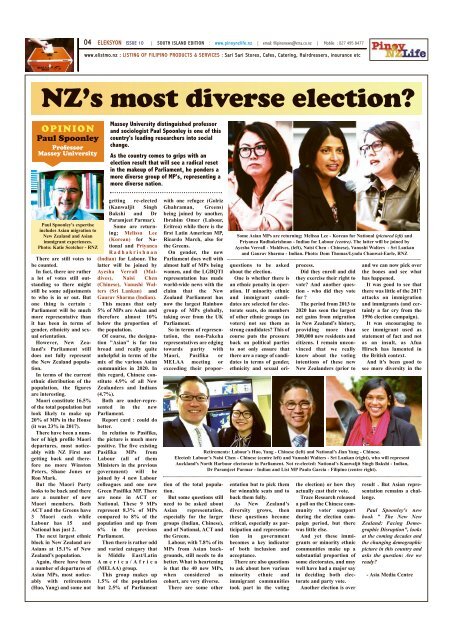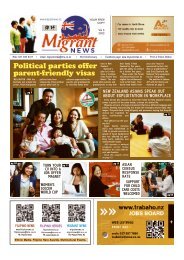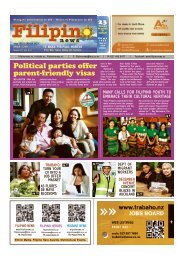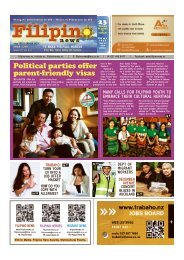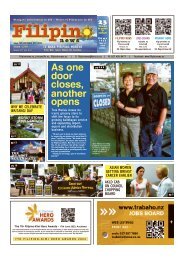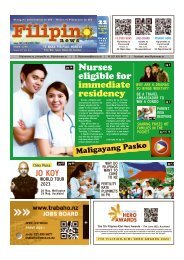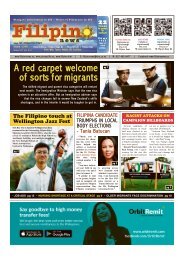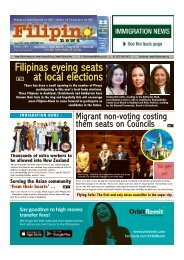PNZLIFE NOV 2020
www.pinoynzlife.nz - South Island's only Filipino community newspaper www.filipinonews.nz - North Island's only Filipino community newspaper www.filipino.kiwi - Wellington's only Filipino community newspaper
www.pinoynzlife.nz - South Island's only Filipino community newspaper
www.filipinonews.nz - North Island's only Filipino community newspaper
www.filipino.kiwi - Wellington's only Filipino community newspaper
Create successful ePaper yourself
Turn your PDF publications into a flip-book with our unique Google optimized e-Paper software.
04 ELEKSYON ISSUE 10 | SOUTH ISLAND EDITION : www.pinoynzlife.nz | email: filipinonews@xtra.co.nz | Mobile : 027 495 8477<br />
www.elistmo.nz : LISTING OF FILIPINO PRODUCTS & SERVICES : Sari Sari Stores, Cafes, Catering, Hairdressers, insurance etc<br />
NZ’s most diverse election?<br />
OPINION<br />
Paul Spoonley<br />
Professor<br />
Massey University<br />
Massey University distinguished professor<br />
and sociologist Paul Spoonley is one of this<br />
country's leading researchers into social<br />
change.<br />
As the country comes to grips with an<br />
election result that will see a radical reset<br />
in the makeup of Parliament, he ponders a<br />
more diverse group of MP's, representing a<br />
more diverse nation.<br />
Paul Spoonley's expertise<br />
includes Asian migration to<br />
New Zealand and Asian<br />
immigrant experiences.<br />
Photo: Katie Scotcher - RNZ<br />
There are still votes to<br />
be counted.<br />
In fact, there are rather<br />
a lot of votes still outstanding<br />
so there might<br />
still be some adjustments<br />
to who is in or out. But<br />
one thing is certain :<br />
Parliament will be much<br />
more representative than<br />
it has been in terms of<br />
gender, ethnicity and sexual<br />
orientation.<br />
However, New Zealand's<br />
Parliament still<br />
does not fully represent<br />
the New Zealand population.<br />
In terms of the current<br />
ethnic distribution of the<br />
population, the figures<br />
are interesting.<br />
Maori constitute 16.5%<br />
of the total population but<br />
look likely to make up<br />
20% of MPs in the House<br />
(it was 23% in 2017).<br />
There have been a number<br />
of high profile Maori<br />
departures, most noticeably<br />
with NZ First not<br />
getting back and therefore<br />
no more Winston<br />
Peters, Shane Jones or<br />
Ron Mark.<br />
But the Maori Party<br />
looks to be back and there<br />
are a number of new<br />
Maori members. Both<br />
ACT and the Greens have<br />
3 Maori each while<br />
Labour has 15 and<br />
National has just 2.<br />
The next largest ethnic<br />
block in New Zealand are<br />
Asians at 15.1% of New<br />
Zealand’s population.<br />
Again, there have been<br />
a number of departures of<br />
Asian MPs, most noticeably<br />
with retirements<br />
(Huo, Yang) and some not<br />
getting re-elected<br />
(Kanwaljit Singh<br />
Bakshi and Dr<br />
Paramjeet Parmar).<br />
Some are returning;<br />
Melissa Lee<br />
(Korean) for National<br />
and Priyanca<br />
Radhakrishnan<br />
(Indian) for Labour. The<br />
latter will be joined by<br />
Ayesha Verrall (Maldives),<br />
Naisi Chen<br />
(Chinese), Vanushi Walters<br />
(Sri Lankan) and<br />
Gaurav Sharma (Indian).<br />
This means that only<br />
5% of MPs are Asian and<br />
therefore almost 10%<br />
below the proportion of<br />
the population.<br />
Of course, the designation<br />
"Asian" is far too<br />
broad and really quite<br />
unhelpful in terms of the<br />
mix of the various Asian<br />
communities in <strong>2020</strong>. In<br />
this regard, Chinese constitute<br />
4.9% of all New<br />
Zealanders and Indians<br />
(4.7%).<br />
Both are under-represented<br />
in the new<br />
Parliament.<br />
Report card : could do<br />
better.<br />
In relation to Pasifika,<br />
the picture is much more<br />
positive. The five existing<br />
Pasifika MPs from<br />
Labour (all of them<br />
Ministers in the previous<br />
government) will be<br />
joined by 4 new Labour<br />
colleagues and one new<br />
Green Pasifika MP. There<br />
are none in ACT or<br />
National. These 9 MPs<br />
represent 8.3% of MPs<br />
compared to 8% of the<br />
population and up from<br />
6% in the previous<br />
Parliament.<br />
Then there is rather odd<br />
and varied category that<br />
is Middle East/Latin<br />
America/Africa<br />
(MELAA) group.<br />
This group makes up<br />
1.5% of the population<br />
but 2.5% of Parliament<br />
with one refugee (Golriz<br />
Ghahraman, Greens)<br />
being joined by another,<br />
Ibrahim Omer (Labour,<br />
Eritrea) while there is the<br />
first Latin American MP,<br />
Ricardo March, also for<br />
the Greens.<br />
On gender, the new<br />
Parliament does well with<br />
almost half of MPs being<br />
women, and the LGBQTI<br />
representation has made<br />
world-wide news with the<br />
claim that the New<br />
Zealand Parliament has<br />
now the largest Rainbow<br />
group of MPs globally,<br />
taking over from the UK<br />
Parliament.<br />
So in terms of representation,<br />
the non-Pakeha<br />
representatives are edging<br />
towards parity with<br />
Maori, Pasifika or<br />
MELAA meeting or<br />
exceeding their proportion<br />
of the total population.<br />
But some questions still<br />
need to be asked about<br />
Asian representation,<br />
especially for the larger<br />
groups (Indian, Chinese),<br />
and of National, ACT and<br />
the Greens.<br />
Labour, with 7.8% of its<br />
MPs from Asian backgrounds,<br />
still needs to do<br />
better. What is heartening<br />
is that the 40 new MPs,<br />
when considered as<br />
cohort, are very diverse.<br />
There are some other<br />
Some Asian MPs are returning; Melissa Lee - Korean for National (pictured left) and<br />
Priyanca Radhakrishnan - Indian for Labour (centre). The latter will be joined by<br />
Ayesha Verrall - Maldives, (left), Naisi Chen - Chinese), Vanushi Walters - Sri Lankan<br />
and Gaurav Sharma - Indian. Photo: Dom Thomas/Lynda Chanwai-Earle, RNZ<br />
questions to be asked<br />
about the election.<br />
One is whether there is<br />
an ethnic penalty in operation.<br />
If minority ethnic<br />
and immigrant candidates<br />
are selected for electorate<br />
seats, do members<br />
of other ethnic groups (as<br />
voters) not see them as<br />
strong candidates? This of<br />
course puts the pressure<br />
back on political parties<br />
to not only ensure that<br />
there are a range of candidates<br />
in terms of gender,<br />
ethnicity and sexual orientation<br />
but to pick them<br />
for winnable seats and to<br />
back them fully.<br />
As New Zealand’s<br />
diversity grows, then<br />
these questions become<br />
critical, especially as participation<br />
and representation<br />
in government<br />
becomes a key indicator<br />
of both inclusion and<br />
acceptance.<br />
There are also questions<br />
to ask about how various<br />
minority ethnic and<br />
immigrant communities<br />
took part in the voting<br />
process.<br />
Did they enroll and did<br />
they exercise their right to<br />
vote? And another question<br />
- who did they vote<br />
for ?<br />
The period from 2013 to<br />
<strong>2020</strong> has seen the largest<br />
net gains from migration<br />
in New Zealand’s history,<br />
providing more than<br />
300,000 new residents and<br />
citizens. I remain unconvinced<br />
that we really<br />
know about the voting<br />
intentions of these new<br />
New Zealanders (prior to<br />
the election) or how they<br />
actually cast their vote.<br />
Trace Research released<br />
a poll on the Chinese community<br />
voter support<br />
during the election campaign<br />
period, but there<br />
was little else.<br />
And yet these immigrants<br />
or minority ethnic<br />
communities make up a<br />
substantial proportion of<br />
some electorates, and may<br />
well have had a major say<br />
in deciding both electorate<br />
and party vote.<br />
Another election is over<br />
and we can now pick over<br />
the bones and see what<br />
has happened.<br />
It was good to see that<br />
there was little of the 2017<br />
attacks on immigration<br />
and immigrants (and certainly<br />
a far cry from the<br />
1996 election campaign).<br />
It was encouraging to<br />
see immigrant used as<br />
statement of fact and not<br />
as an insult, as Afua<br />
Hirsch has lamented in<br />
the British context.<br />
And it's been good to<br />
see more diversity in the<br />
Retirements: Labour’s Huo, Yang - Chinese (left) and National’s Jian Yang - Chinese.<br />
Elected: Labour’s Naisi Chen - Chinese (centre left) and Vanushi Walters - Sri Lankan (right), who will represent<br />
Auckland's North Harbour electorate in Parliament. Not re-elected: National’s Kanwaljit Singh Bakshi - Indian,<br />
Dr Paramjeet Parmar - Indian and List MP Paulo Garcia - Filipino (centre right).<br />
result . But Asian representation<br />
remains a challenge.<br />
Paul Spoonley's new<br />
book " The New New<br />
Zealand: Facing Demographic<br />
Disruption", looks<br />
at the coming decades and<br />
the changing demographic<br />
picture in this country and<br />
asks the question: Are we<br />
ready?<br />
- Asia Media Centre


